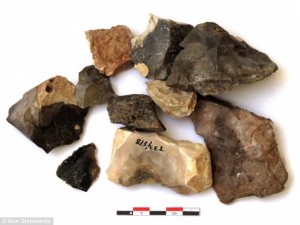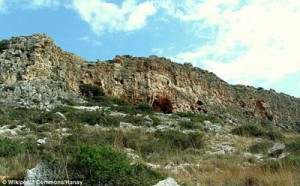Sunday Times 2
Did humans first master fire in Israel 350,000 years ago?
Early humans first began to master fire around 350,000 years ago, helping to drive the development of complex culture among our ancestors, new archaeological evidence has revealed.
Flint fragments discovered in a cave in the limestone cliffs of Mount Carmel, close to Haifa on the Mediterranean coast of northern Israel, have provided the oldest signs of humans controlling fire.
The Tabun Cave is an archaeological site that holds evidence of having being inhabited by humans and their ancestors for around 500,000 years.
By examining flint debris and tools found in the cave, archaeologists found that some of them show discolouration, cracking and small round depressions that are signs of exposure to fire.
The researchers looked at flints from 100 layers of sediment in the lowermost 16 metres of the cave. In those that are older than 350,000 years, none of the flints were found to be burned.
However, after that there is a sudden explosion in the number of flints that were exposed to fire.
Given that wildfires rarely spread into caves due to the lack of vegetation, the scientists believe these flints were burned in the fires built within the cave by prehistoric humans.
The discovery means our human ancestors in this area of Israel mastered control of fire nearly 50,000 years before any evidence previously found to suggest regular human use of fire.
It could bring new understanding to the development of culture and human behaviour.
While 350,000 years ago, the lower Paeleolithic period, is too late for fire to have played a role in the development of human’s big brains as some scientists have suggested, it would have played a key role in the origins of social behaviour, argue the scientists behind the latest study.
It has also been suggested that control of fire was one of the key developments that allowed early humans to spread into colder climates, but this expansion had already begun by 350,000 years ago.
Dr Ron Shimelmitz, an archaeologist at the University of Haifa who led the new study, said: ‘Understanding the time frame of this “technological mutation” will help explain aspects of our anatomical evolution and encephalization over the last million years.
‘It will also provide an important perspective on hominin dispersals out of Africa and the colonization of temperateenvironments, as well as the origins of social developments such as the formation of provisioned base camps.’

The Tabun Cave was discovered in the limestone cliffs of Mount Carmel around 14 miles south of Haifa, Israel
Early humans are widely accepted to have gained complete widespread control of fire by around 125,000 years ago with the ability to kindle and light fires themselves.
However, the time when human ancestors first gained this essential technological ability has been highly controversial.
Some anthropologists claim that early humans, such asHomo erectus, began exploiting fire as long as 1.5 million years ago while still in Africa.
However, much of this evidence – which consists of heated clays and charcoal fragments – is disputed and could have occurred as a result of natural bush fires.
There are some who believe that fire played an instrumental role in the evolution of early hominins around two million years ago when our teeth and guts became smaller.
They have also argued that fire played a key role in the evolution of larger human brains.
However, many experts believe that early uses of fire may well have been opportunistic where early humans used natural bush fires rather than lighting fires themselves.
The artifacts found at these sites often show few signs of burning, suggesting fire was not used regularly, according to Dr Shimelmitz and his colleagues, whose research is published in the Journal of Human Evolution.
They say their findings at Tabun Cave are supported by evidence from other recent discoveries.
Burnt flints, bones and ash found in the Qesem Cave in Tel Aviv, Israel, point towards the use of a hearth in this cave that has been dated to around 300,000 years ago.
He said: ‘While the earliest evidence of fire associated with hominin activities is much older, the data presented here indicate that fire became a regular and constant part of hominin behavioral adaptations in Eurasia only after 350,000 years ago.
‘The benefits of fire for processing food, altering raw materials or enhancing social interactions would be fully realized only when use of fire shifted from opportunistic and occasional to habitual and regular.
‘Regular use of fire changed hominin existence and influenced the direction of evolution in our lineage in a diversity of ways .
‘To the extent that humans’ physical, cognitive and social evolution was affected by the emergence of habitual fire use, weshould be able to trace evidence for such impacts most clearly in the hominins that inhabited the landscape over the last 350,000 years ago.’
Tabun Cave has proved to be a rich site for archaeological evidence and is thought to have been inhabited intermittently through the Lower and Middle Paleolithic ages between 500,000 and 40,000 yaers ago.
Around 82 feet of sand, silt and clay have built up in the cave, allowing archaeologists to date the signs of human habitation left in each layer.
Among the remains found there were the skull fragments and bones from a female Neanderthal, that is thought to be around 120,000 years old.
© Daily Mail, London

